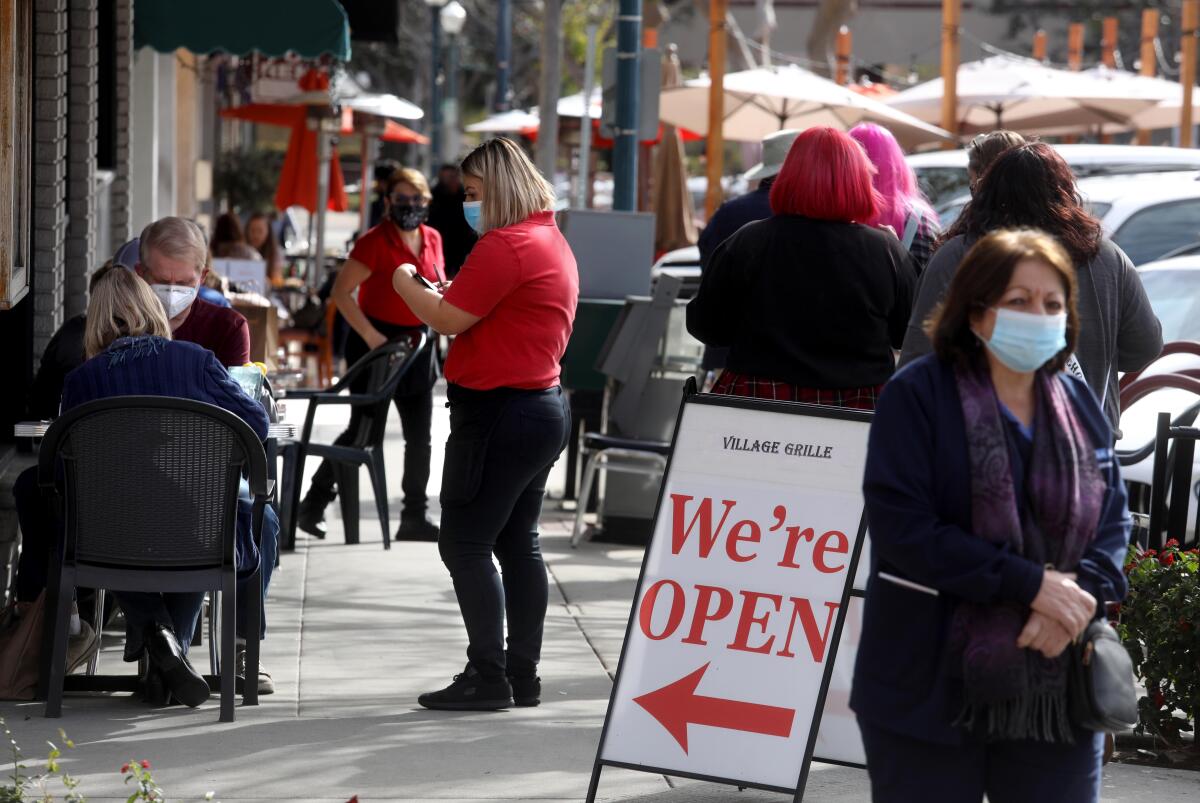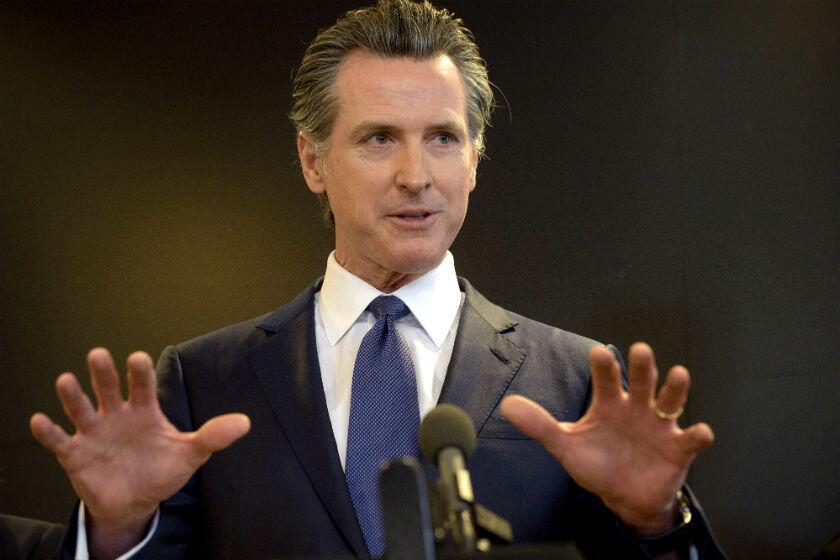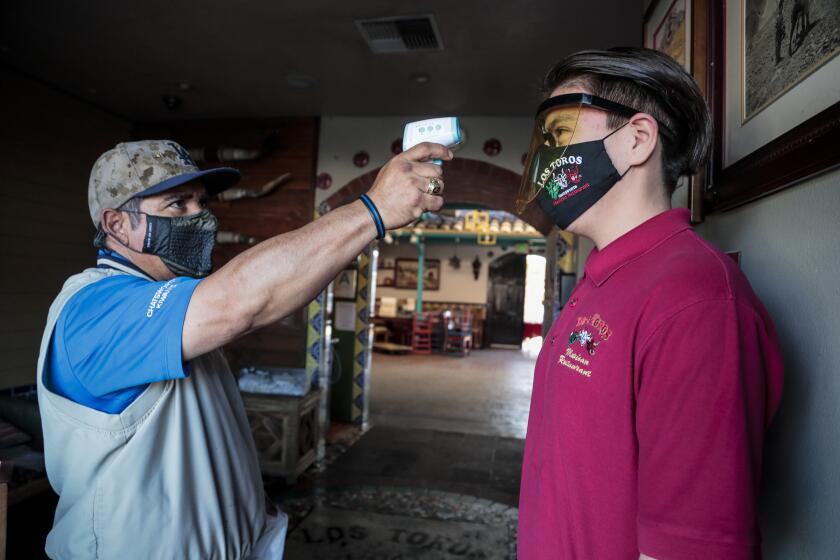California’s job losses were worse than expected this winter

- Share via
California’s winter COVID-19 surge took a grim toll on jobs as the state’s recovery lagged compared with the nation’s overall, according to recalculated state data published Friday.
The Golden State‘s economy may now be poised to turn a corner thanks to accelerating vaccinations, a loosening of restrictions on businesses and schools, and massive federal aid, but steep labor losses have delayed recovery: In December and January, the state shed 145,300 payroll jobs, according to a report from the Employment Development Department.
“As it turns out, the labor market fallout in 2020 was significantly worse than original estimates suggested,” said Taner Osman, research manager at Beacon Economics in Los Angeles. “While we expect a strong recovery in 2021, it would take an unprecedented hiring surge to regain the lost jobs, as well as the jobs we would have added during normal times.”
The losses in December and January reversed the autumn’s upward trend when businesses had begun to reopen and bring back workers, only to be shut down again as the virus spread out of control.
By January, California had recovered just 39% of the 2.7 million jobs that evaporated when the virus took hold last year — down from 46% in November.
Nationwide, a far larger share was recovered by January. With many states avoiding strict lockdowns, 56% of U.S. jobs had returned.
California payrolls counted 15.87 million jobs in January — a 10.2% contraction since February of last year. By contrast, U.S. employment shrank 6.5% over the same period.
UCLA economists, in a quarterly forecast released this week, predict California and the U.S. economy will experience near-record growth this year after a catastrophic recession.
On Thursday, President Biden signed a $1.9-trillion economic relief bill that will pump more than $150 billion into California’s economy, funneling aid to individuals, businesses, and to the state and local governments.
The UCLA forecasters said payrolls won’t recover soon, given the severity of the downturn. By the end of 2023, the nation will still be 5 million jobs short of where it would have been without the pandemic, they estimate.
With vaccinations and federal relief, a “euphoric resumption of social activity” will now power the U.S. and California economies despite lingering inequality.
California’s unemployment rate dropped to 9% in January from 9.3% in December — significantly higher than November’s 8.2% level. It was 3.9% before the pandemic.
The U.S. unemployment rate was a far rosier 6.3% in January.
“California’s labor market has seriously underperformed the nation as a whole,” said Scott Anderson, an economist at Bank of the West. “The new data paints a darker picture of the hole California fell into early in the pandemic and its anemic recovery.”
The modest January unemployment improvement was due in part to a troubling pandemic trend: job market dropouts. As workers retired, were discouraged, or quit to care for children, California’s labor force — which includes both workers and job seekers — fell by 36,500, and these people were no longer counted as unemployed.
Year-over-year the labor force contracted by 768,100 workers.
Anderson placed blame on the COVID-19 winter resurgence and resulting stay-at-home orders and business restrictions. Even passage of a $908-billion federal stimulus bill in December was not enough to stem job losses, he said.
The wealthy state is failing many of its workers, a report commissioned by Gov. Gavin Newsom says, highlighting how California continues to grapple with a starkly unequal economy. It calls for “moonshot goals,” including guaranteed jobs for all Californians who want them.
Leisure and hospitality businesses lost 70,600 jobs in January, the most of any sector, reflecting restaurant and hotel closures. The sector has shed 799,400 positions year over year — far more than any other industry — as international and business travel dried up.
The January job statistics, which are gathered mid-month, do not reflect Gov. Gavin Newsom’s lifting of many business restrictions on Jan. 25.
California is averaging 3,881 virus cases daily, a 32% drop from two weeks ago. About 19.1% of Californians have received at least one vaccine dose.
Even as the virus abates and regulations loosen, Golden State employers have continued to shed jobs at a higher rate than the nation’s.
In the week of March 6, 105,861 California employees filed new unemployment claims — a 19% jump over the previous week, increasing the total to 715,396 people continuing to receive benefits, the U.S. Labor department reported.
By contrast, U.S. jobless claims dropped by 6.2% in the same week.
New state job postings rose in February but fell in the first week of March, said Michael Bernick, a former director of the state employment agency. Small-business revenues and small-business openings in California remain unchanged over the last month, down more than 30% since the start of the pandemic.
Millions of Golden State workers are staring down a pandemic with no clear access to an economic safety net if they take time off, after emergency sick-leave laws requiring two weeks’ paid leave expired in January. The Legislature will soon vote on whether to reinstate the mandate.
As in the lengthy 2008-09 recovery, employers may be reluctant to hire new workers given how recently they may have cut staff, Bernick said.
Besides the steep drop in leisure and hospitality jobs in January, statewide losses occurred in education and health services (a loss of 10,000), in manufacturing (a loss of 4,600), in construction (a loss of 4,000) and in the “other services” category, which includes businesses such as hair salons and auto repair shops (a loss of 3,300).
Sectors gaining positions included government (up by 3,600), professional and business services (also up by 3,600), financial activities (up by 600) and information, which includes some technology jobs (also up by 600).
Los Angeles County’s net job loss in January was higher than that of the entire state: 84,800, as compared with 69,900, because of the city’s reliance on the still-stagnant tourism and entertainment industries.
L.A. County, with January payrolls of slightly more than 4 million people, had a 12.7% unemployment rate that month, the same as in December. A year earlier, the county’s joblessness rate was 4.8%.
Northern California’s thriving technology sector, in which employees could continue working from home, has suffered comparatively few job losses. The unemployment rate in San Francisco was 6.3% in January, and 5.7% in Santa Clara and San Mateo Counties.
Orange County shed 51,000 jobs in January, down to a total of 1.47 million. Unemployment stood at 7.4%, the same as in December.
In the Inland Empire, which encompasses Riverside and San Bernardino counties, payrolls dropped to about 1.47 million in January from December as employers shed 37,500 positions. Unemployment was 8.6%, down a notch from December’s 8.7%.
More to Read
Inside the business of entertainment
The Wide Shot brings you news, analysis and insights on everything from streaming wars to production — and what it all means for the future.
You may occasionally receive promotional content from the Los Angeles Times.














